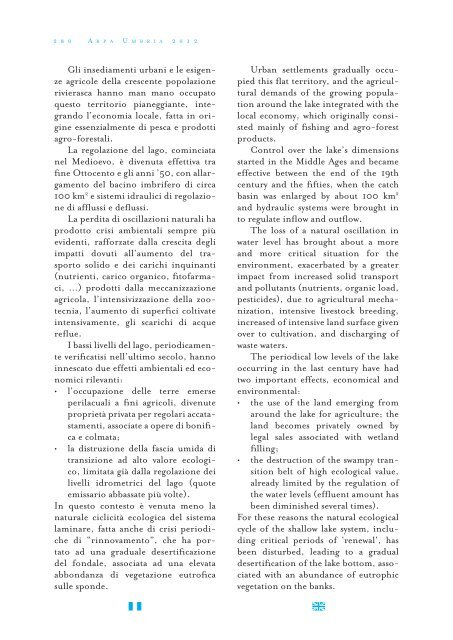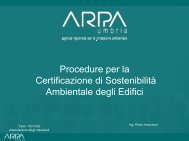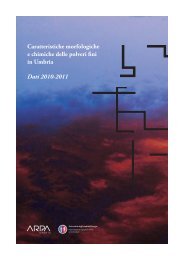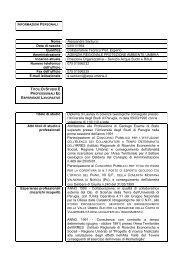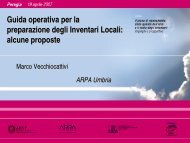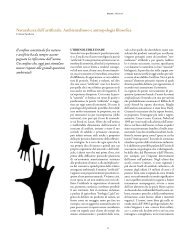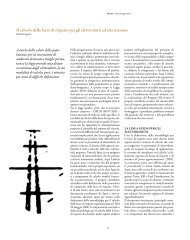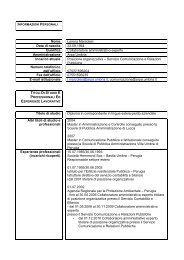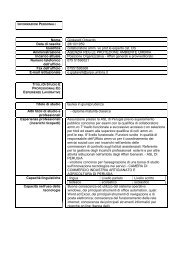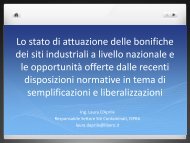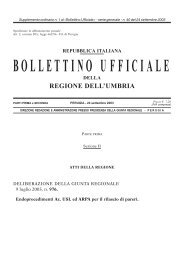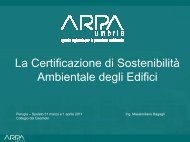Tutela ambientale del Lago Trasimeno - ARPA Umbria
Tutela ambientale del Lago Trasimeno - ARPA Umbria
Tutela ambientale del Lago Trasimeno - ARPA Umbria
Create successful ePaper yourself
Turn your PDF publications into a flip-book with our unique Google optimized e-Paper software.
2 8 0 A r p a U m b r i a 2 0 1 2<br />
Gli insediamenti urbani e le esigenze<br />
agricole <strong>del</strong>la crescente popolazione<br />
rivierasca hanno man mano occupato<br />
questo territorio pianeggiante, integrando<br />
l’economia locale, fatta in origine<br />
essenzialmente di pesca e prodotti<br />
agro-forestali.<br />
La regolazione <strong>del</strong> lago, cominciata<br />
nel Medioevo, è divenuta effettiva tra<br />
fine Ottocento e gli anni ’50, con allargamento<br />
<strong>del</strong> bacino imbrifero di circa<br />
100 km 2 e sistemi idraulici di regolazione<br />
di afflussi e deflussi.<br />
La perdita di oscillazioni naturali ha<br />
prodotto crisi ambientali sempre più<br />
evidenti, rafforzate dalla crescita degli<br />
impatti dovuti all’aumento <strong>del</strong> trasporto<br />
solido e dei carichi inquinanti<br />
(nutrienti, carico organico, fitofarmaci,<br />
…) prodotti dalla meccanizzazione<br />
agricola, l’intensivizzazione <strong>del</strong>la zootecnia,<br />
l’aumento di superfici coltivate<br />
intensivamente, gli scarichi di acque<br />
reflue.<br />
I bassi livelli <strong>del</strong> lago, periodicamente<br />
verificatisi nell’ultimo secolo, hanno<br />
innescato due effetti ambientali ed economici<br />
rilevanti:<br />
• l’occupazione <strong>del</strong>le terre emerse<br />
perilacuali a fini agricoli, divenute<br />
proprietà privata per regolari accatastamenti,<br />
associate a opere di bonifica<br />
e colmata;<br />
• la distruzione <strong>del</strong>la fascia umida di<br />
transizione ad alto valore ecologico,<br />
limitata già dalla regolazione dei<br />
livelli idrometrici <strong>del</strong> lago (quote<br />
emissario abbassate più volte).<br />
In questo contesto è venuta meno la<br />
naturale ciclicità ecologica <strong>del</strong> sistema<br />
laminare, fatta anche di crisi periodiche<br />
di “rinnovamento”, che ha portato<br />
ad una graduale desertificazione<br />
<strong>del</strong> fondale, associata ad una elevata<br />
abbondanza di vegetazione eutrofica<br />
sulle sponde.<br />
Urban settlements gradually occupied<br />
this flat territory, and the agricultural<br />
demands of the growing population<br />
around the lake integrated with the<br />
local economy, which originally consisted<br />
mainly of fishing and agro-forest<br />
products.<br />
Control over the lake’s dimensions<br />
started in the Middle Ages and became<br />
effective between the end of the 19th<br />
century and the fifties, when the catch<br />
basin was enlarged by about 100 km 2<br />
and hydraulic systems were brought in<br />
to regulate inflow and outflow.<br />
The loss of a natural oscillation in<br />
water level has brought about a more<br />
and more critical situation for the<br />
environment, exacerbated by a greater<br />
impact from increased solid transport<br />
and pollutants (nutrients, organic load,<br />
pesticides), due to agricultural mechanization,<br />
intensive livestock breeding,<br />
increased of intensive land surface given<br />
over to cultivation, and discharging of<br />
waste waters.<br />
The periodical low levels of the lake<br />
occurring in the last century have had<br />
two important effects, economical and<br />
environmental:<br />
• the use of the land emerging from<br />
around the lake for agriculture; the<br />
land becomes privately owned by<br />
legal sales associated with wetland<br />
filling;<br />
• the destruction of the swampy transition<br />
belt of high ecological value,<br />
already limited by the regulation of<br />
the water levels (effluent amount has<br />
been diminished several times).<br />
For these reasons the natural ecological<br />
cycle of the shallow lake system, including<br />
critical periods of ‘renewal’, has<br />
been disturbed, leading to a gradual<br />
desertification of the lake bottom, associated<br />
with an abundance of eutrophic<br />
vegetation on the banks.


